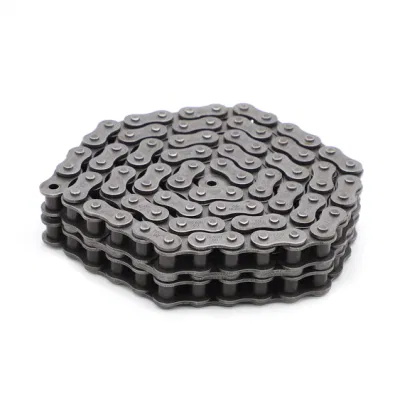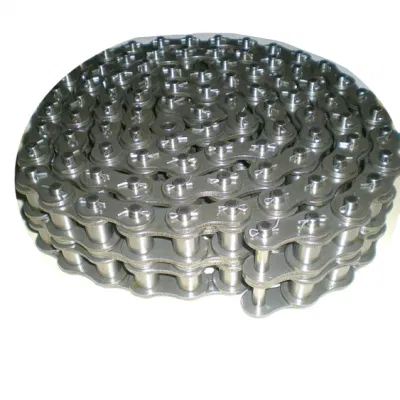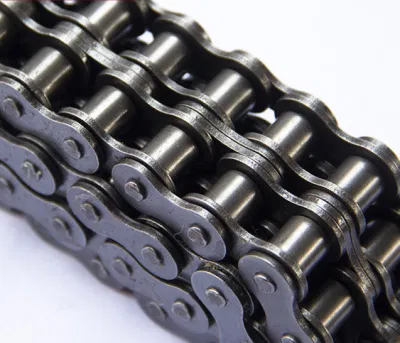Product Description
Product Description
Product Parameters
| Standard | GB, ISO, ANSI, DIN |
| Type | Standard A and standard B precision roller chain, conveyor chain; |
| special chain with accessories, welding chain, leaf chain and sprocket | |
| ANSI chain No. | 40,50,60,80,100,120,140,160,180,200,240; |
| C40,C50,C60,C80,C100,C120,C140,C160; | |
| DIN/ISO chain No. | 08A,10A,12A,16A,20A,24A,28A,32A,36A,40A,48A; |
| C08A,C10A,C12A,C16A,C20A,C24A,C28A,C32A; | |
| Application | Food processing, pharmaceutical and chemical industries, electronics, machinery; |
| household appliances, automotive manufacturing, metallurgy, sewage treatment | |
| Series | A series,B series |
More Products
Advantage
Certifications
DETAILS ABOUT CHINAMFG CHAIN
Exhibition
Workshop
Application
Packaging Details
Shipping
FAQ
1. Are you manufacturer or trade Company?
We are a factory founded in 1997 with trade team for international service.
2. What terms of payment you usually use?
T/T 30% deposit and 70% against document, Western Union, L/C at sight
3. What is your lead time for your goods?
Normally 35 days after confirmed order. 30 days could be available in low season for some items (during May to July), and 45 days during new year and hot season ( Jan to March).
4. Samples
For customers who need sample confirmation before ordering, please bear in mind that the following policy will be adopted:
1) All samples are free of charge with the maximum value not exceeding USD 100.
2) The courier cost for the first-time sample sending will be charged for by the consignee. We will send the samples with freight to be collected. So please inform your account with FedEx, UPS, DHL or TNT so that we can proceed promptly.
3) The first-time courier cost will be totally deducted from the contract value of the trial cooperation.
| Usage: | Transmission Chain, Drag Chain, Conveyor Chain |
|---|---|
| Material: | Stainless steel |
| Surface Treatment: | Polishing |
| Feature: | Heat Resistant |
| Chain Size: | 1/2"*3/32" |
| Structure: | Roller Chain |
| Samples: |
US$ 0/Piece
1 Piece(Min.Order) | |
|---|
| Customization: |
Available
| Customized Request |
|---|

What are the safety precautions when working with bush chains?
Working with bush chains requires adherence to certain safety precautions to ensure the well-being of operators and prevent accidents. Here are some important safety measures to consider:
1. Personal protective equipment (PPE): Operators should wear appropriate PPE, including safety glasses, gloves, and protective clothing, to protect themselves from potential hazards such as flying debris, pinching, or entanglement.
2. Training and knowledge: Operators should be properly trained in the operation and maintenance of bush chains. They should have a thorough understanding of the equipment, including its components, functions, and potential hazards. Training should cover safe operating procedures, including start-up, shutdown, and emergency procedures.
3. Lockout/tagout procedures: Before performing any maintenance or repair work on a bush chain, proper lockout/tagout procedures should be followed. This involves isolating the power source, de-energizing the equipment, and securing it with lockout devices or tags to prevent accidental startup.
4. Regular inspections: Regular inspections should be conducted to identify any signs of wear, damage, or misalignment in the bush chain. This includes checking for loose bolts, worn sprockets, damaged links, or any other issues that could compromise the chain’s integrity. Any identified problems should be promptly addressed to prevent further damage or accidents.
5. Proper lifting and handling: When handling bush chains, proper lifting techniques should be employed to prevent strain or injury. Chains should be lifted using appropriate lifting equipment, and operators should avoid placing themselves in a position where they could be caught between moving parts.
6. Clean and well-maintained work environment: The work area should be clean, well-lit, and free from clutter or obstructions. This ensures that operators have clear visibility and can safely access the bush chain without tripping or other hazards.
7. Follow manufacturer guidelines: It is important to follow the manufacturer’s guidelines and recommendations for the safe use, maintenance, and inspection of the specific bush chain being used. This includes following recommended lubrication practices, tensioning guidelines, and any other instructions provided by the manufacturer.
By adhering to these safety precautions, operators can mitigate potential risks associated with working with bush chains and ensure a safe working environment for themselves and others involved in the operation and maintenance of the equipment.

What are the design considerations for a bush chain system?
When designing a bush chain system, several key considerations should be taken into account to ensure its reliable and efficient operation. These design considerations include:
1. Load capacity: Evaluate the expected loads that the bush chain system will need to handle. Consider the weight, size, and type of materials or products being conveyed or transmitted. Select a bush chain with a suitable load capacity to ensure it can withstand the required loads.
2. Speed and acceleration: Determine the desired operating speed and acceleration of the bush chain system. This will influence the selection of chain pitch, material, and lubrication requirements. Higher speeds may require additional considerations such as reduced friction or increased precision.
3. Environmental conditions: Evaluate the operating environment for the bush chain system. Consider factors such as temperature, humidity, dust, chemicals, and presence of corrosive or abrasive substances. Select a bush chain material and coating that can withstand the environmental conditions and resist corrosion or wear.
4. Space limitations: Assess the available space for the installation of the bush chain system. Consider the dimensions and layout of the equipment, conveyor, or transmission system. Ensure that there is sufficient clearance for the chain’s movement and that the system can be properly tensioned and aligned.
5. Alignment and tensioning: Proper tensioning and alignment are critical for the smooth operation of a bush chain system. Design the system to include tensioners, idler sprockets, or adjustable mounting options to facilitate easy tensioning and alignment adjustments.
6. Lubrication and maintenance: Determine the lubrication requirements of the bush chain system. Consider the frequency and method of lubrication, as well as any accessibility constraints for maintenance. Select a lubrication method that suits the application, such as manual lubrication, automatic lubrication systems, or self-lubricating bush chains.
7. Safety considerations: Ensure that the bush chain system is designed with appropriate safety measures. Incorporate guards, covers, or enclosures where necessary to prevent accidental contact with moving parts. Consider emergency stop systems and safety interlocks for the protection of personnel and equipment.
By carefully considering these design factors, a bush chain system can be optimized for performance, reliability, and longevity in a specific application or industry.

How do you select the right bush chain for your application?
Choosing the right bush chain for your application is essential to ensure optimal performance and longevity. Here are some factors to consider when selecting a bush chain:
1. Load Capacity: Evaluate the maximum load that the chain will need to transmit. Consider factors such as weight, acceleration, and shock loads. Choose a bush chain with a load capacity that exceeds the anticipated load to ensure reliable operation.
2. Speed: Determine the operating speed of the chain. Higher speeds may require chains with specialized designs to minimize wear, reduce friction, and maintain accurate timing.
3. Environmental Conditions: Assess the environmental conditions in which the chain will operate. Consider factors such as temperature, humidity, dust, chemicals, and exposure to corrosive substances. Select a bush chain that is designed to withstand the specific conditions of your application.
4. Size and Configuration: Determine the required chain size based on the available space and the dimensions of the sprockets or pulleys. Consider the pitch, width, and overall dimensions of the chain. Additionally, assess whether a standard or custom configuration is needed to meet the application requirements.
5. Lubrication Requirements: Determine the lubrication method and frequency required for the chain. Some bush chains are self-lubricating, while others may require regular lubrication. Consider the availability of lubrication systems and the maintenance requirements of the chain.
6. Reliability and Durability: Assess the expected operational lifespan and the reliability requirements of your application. Look for bush chains from reputable manufacturers known for producing high-quality, durable products. Consider factors such as wear resistance, fatigue strength, and overall reliability.
7. Cost: Evaluate the cost-effectiveness of the bush chain, considering both the initial investment and long-term maintenance costs. Balance the performance requirements with the available budget.
Consult with a knowledgeable supplier or engineer to ensure you select the right bush chain that meets your specific application requirements. They can provide guidance based on their expertise and help you choose a chain that offers optimal performance and durability.


editor by CX 2023-10-24
